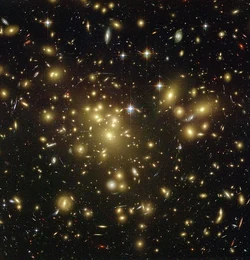
Strong gravitational lensing as observed by the Hubble Space Telescope in Abell 1689 indicates the presence of dark matter—enlarge the image to see the lensing arcs.
In astronomy and cosmology, Dark matter is matter that is inferred to exist from gravitational effects on visible matter and background radiation, but is undetectable by blackbody spectrum - emitted or scattered electromagnetic radiation. Its existence was hypothesized to account for discrepancies between measurements of the mass of galaxies, clusters of galaxies and the entire universe made through dynamical and general relativistic means, and accounting for matter based on counting atoms in stars and the gas and dust of the interstellar medium|interstellar and intergalactic media. According to observations of structures larger than galaxies, as well as Big Bang cosmology, dark matter accounts for 26% of the Mass-energy equivalence|mass-energy density of the observable universe, while the ordinary matter accounts for only 5% (the remainder 69% is attributed to dark energy).
Dark matter was postulated by Fritz Zwicky in 1934, to account for evidence of "missing mass" in the orbital velocities of galaxies in clusters. Subsequently, other observations have indicated the presence of dark matter in the universe, including the galaxy rotation problem|rotational speeds of galaxies, gravitational lensing of background objects by galaxy clusters such as the bullet cluster, and the temperature distribution of hot gas in galaxies and clusters of galaxies.
Dark matter plays a central role in state-of-the-art modeling of structure formation and galaxy evolution, and has measurable effects on the anisotropy|anisotropies observed in the cosmic microwave background. All these lines of evidence suggest that galaxies, clusters of galaxies, and the universe as a whole contain far more matter than that which interacts with electromagnetic radiation: the remainder is frequently called the "dark matter component," even though there is a small amount of baryonic dark matter. The largest part of dark matter, which does not interact with electromagnetic radiation, is not only "dark" but also, by definition, utterly transparent.
The vast majority of the dark matter in the universe is believed to be nonbaryonic, which means that it contains no atoms and does not interact with ordinary matter via electromagnetic forces. The nonbaryonic dark matter includes neutrinos, and possibly hypothetical entities such as axions, or supersymmetric particles. Unlike baryonic dark matter, nonbaryonic dark matter does not contribute to the formation of the elements in the early universe ("big bang nucleosynthesis") and so its presence is revealed only via its gravitational attraction. In addition, if the particles of which it is composed are supersymmetric, they can undergo annihilation interactions with themselves resulting in observable by-products such as photons and neutrinos ("indirect detection").
Nonbaryonic dark matter is classified in terms of the mass of the particle(s) that is assumed to make it up, and/or the typical velocity dispersion of those particles (since more massive particles move more slowly). There are three prominent hypotheses on nonbaryonic dark matter, called Hot Dark Matter (HDM), Warm Dark Matter (WDM), and Cold Dark Matter (CDM); some combination of these is also possible. The most widely discussed models for nonbaryonic dark matter are based on the Cold Dark Matter hypothesis, and the corresponding particle is most commonly assumed to be a neutralino. Hot dark matter might consist of (massive) neutrinos. Cold dark matter would lead to a "bottom-up" formation of structure in the universe while hot dark matter would result in a "top-down" formation scenario.
As important as dark matter is believed to be in the universe, direct evidence of its existence and a concrete understanding of its nature have remained elusive. Though the theory of dark matter remains the most widely accepted theory to explain the anomalies in observed galactic rotation, some alternative theories such as modified Newtonian dynamics and tensor-vector-scalar gravity have been proposed. None of these alternatives, however, has garnered equally widespread support in the scientific community.
